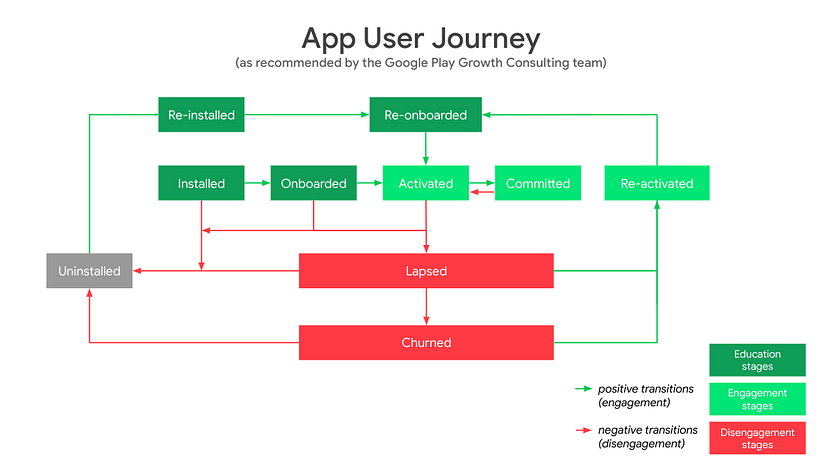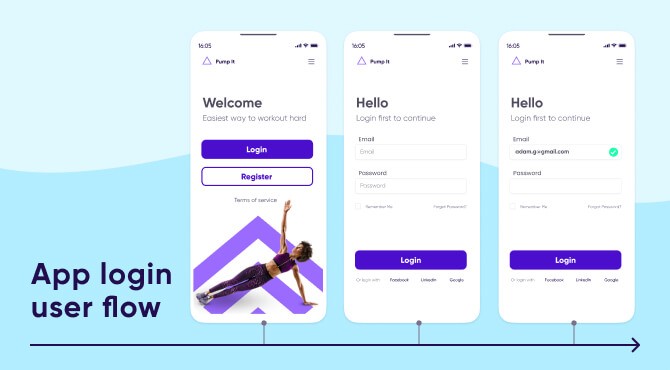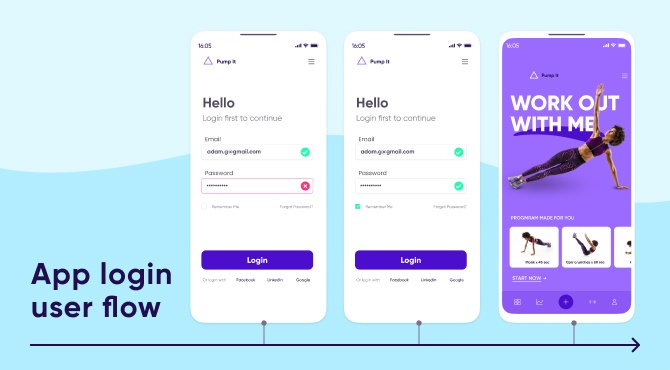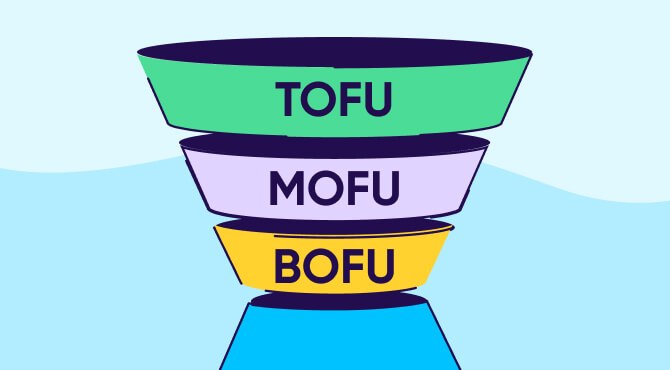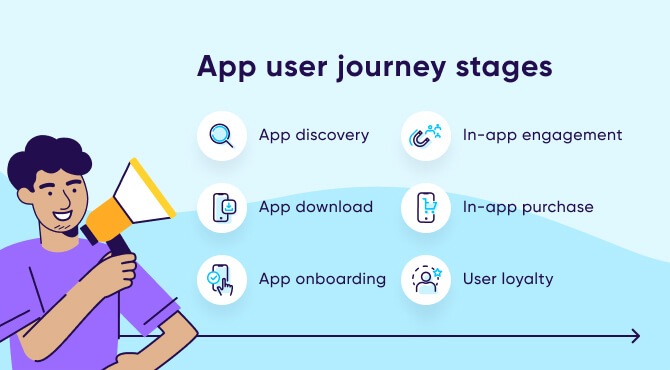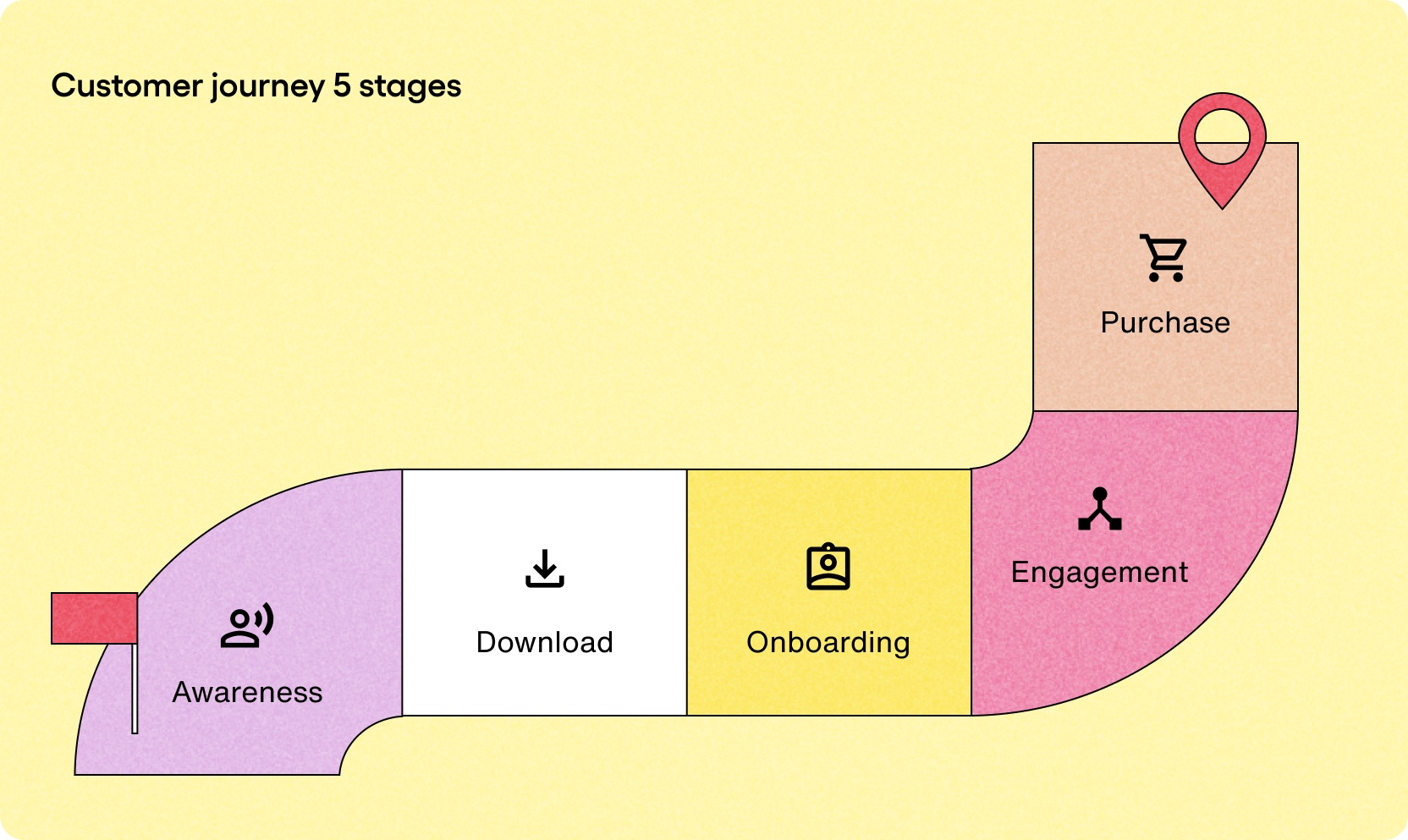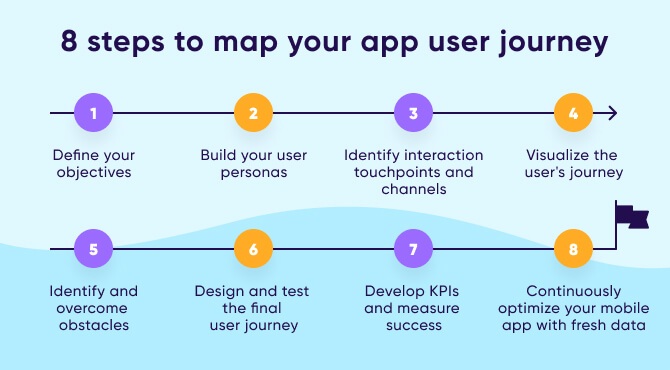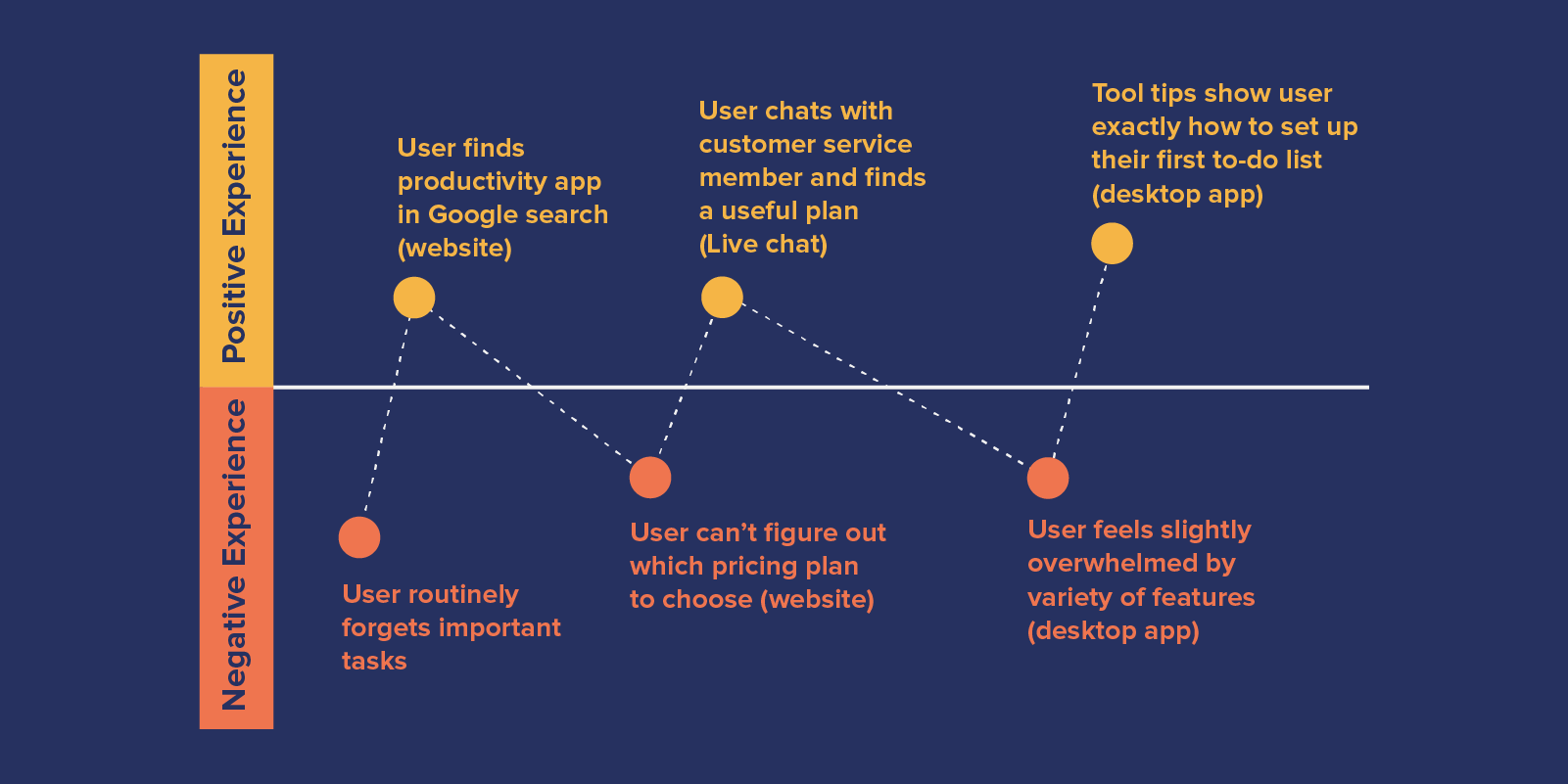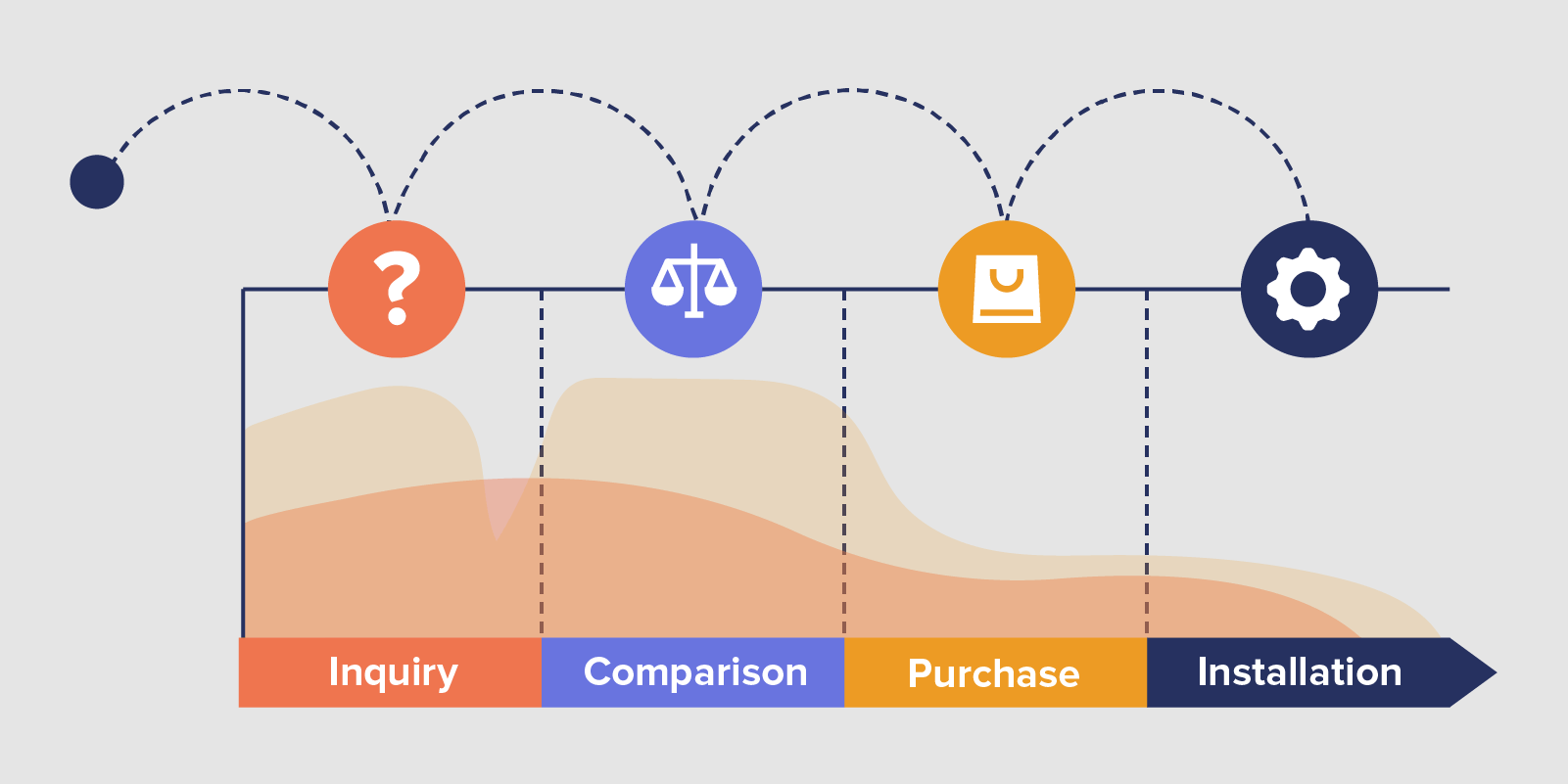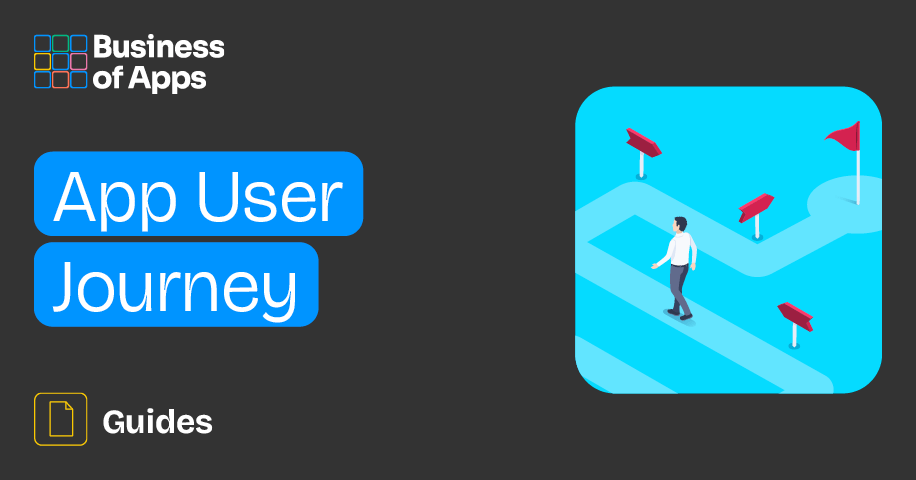
Have you ever wondered what makes your favorite app so delightfully captivating, so engrossing, and so fun to use that it keeps you coming back for more every day? Is it the slick and elegant design, the innovative concept, its ingenious features and impressive functionalities? While these are most certainly important and will go a long way in making your app great, the unsung hero behind the triumph of any mobile app is often its user journey.
Every step a user takes within your app can either make or break their experience. A meticulously planned app user journey will keep your users hooked and coming back for more, transforming a one-time download into a cherished daily ritual. For app developers, mobile marketers, and product managers alike, fully comprehending and optimizing the user journey is the key to crafting an app that people simply can’t resist.
Understanding why users download your app, how they navigate it once installed, and their unique experiences at each step of the user journey empowers you to cater to their needs effectively, which ultimately helps you drive engagement, retention, and conversions.
So, let’s talk about the app user journey. In this guide, we’ll explore all facets of the mobile app user journey. We will talk about what it is and what it isn’t, discuss its benefits and challenges, and learn how to map the app user journey as well as how to analyze and optimize it. We will also be delving into a plethora of examples, case studies, and templates to ensure you’ve got everything you need to ace the mobile app user journey.
Prepare to embark on an illuminating journey through this watershed moment of the app experience. From the initial download to becoming a staple of your users’ daily routines, we’ve got your app user journey covered! Let’s dive in.
But first, the basics. What is an app user journey?
What is an app user journey?
In a nutshell, the app user journey refers to the series of steps that users take within an app as well as the ways they interact with it—from the moment of discovery and app install to the point when they achieve the goals they set out to achieve when they first downloaded your app.
In the context of app user journeys, the goal can take many different forms—for a dating app, it would be finding potential dates/partners; in the case of a gaming app, it would be beating the final game level; the goal for an eCommerce app is most certainly going to be making a purchase; whereas for a health and fitness app, the goal will likely be regular sessions within the app and daily engagement, and so on.
App user journey
Source: Medium
Simple enough, right? As with so many other things in life, it’s easier said than done—developing a killer user journey takes countless hours of app development and meticulous analysis. It involves dissecting user behavior to identify and mend any weak points that hinder users on their path to success, i.e. achieving their goals.
When we speak of weak points, we refer to any stumbling blocks, UX and UI inconsistencies as well as any other sources of hesitation and confusion for users that might prevent them from exploring further and diving deeper into your app. To avoid losing any users and tanking your engagement and retention rates along the way, it’s paramount that you identify and eliminate any and all pain points.
Download our App Engagement Buyer’s Guide, covering all the trends, strategies, and metrics you need to know to ace app engagement in 2025.App Engagement Buyer's Guide
Mapping your app’s user journey empowers you to effectively address these pain points. It will also enable you to efficiently streamline and optimize your app’s UX and UI, which, in turn, will have a positive effect on your app’s engagement and retention and ultimately your users’ lifetime value (LTV).
App user journey FAQs
Before we dive any deeper, let’s address a few elephants in the room to ensure we are all on the same page.
User journey vs. customer journey vs. user flow vs. user funnel
User journeys focus only on user interactions within your app, i.e. download, use of features and functionalities, etc. As such, user journeys only pertain to digital touchpoints within an app. In contrast, the customer journey extends to all touchpoints—both digital and physical—with your brand. In other words, user journeys are a subset of customer journeys.
User journey vs. customer journey
Source: CleverTap
User flows, crafted by UX designers, detail the micro-steps needed to achieve specific actions within an app’s interface. User journeys may reference these steps but primarily aim to extract insights about user experiences. A user journey evaluates user sentiments, desires, and broader perspectives, while a user flow focuses on optimizing a single, specific step within the app, e.g. sign-up or log-in flow. User journeys generally encompass multiple user flows.
User journey vs. user flow (I)
Source: AppsFlyer
Another way of thinking about it is to consider user flows as purpose-driven, i.e. the goal is to get users to complete an action—register, log in, complete a purchase, etc. The goal of a user journey is optimization to ensure smooth navigation and overall experience and increase an app’s engagement and retention rates.
User journey vs. user flow (II)
Source: AppsFlyer
User funnels, on the other hand, track users through a series of steps and serve lead generation and customer conversion purposes. Funnel steps can be part of a user journey, but funnels are generally way broader and more abstract. While user journeys provide granular insights into user interactions and experiences within the app, tailored to specific user segments, funnels focus on the overall steps completed by all users.
User journey vs. user funnel (Top, middle, and bottom of funnel)
Source: AppsFlyer
Why does the app user journey matter?
For mobile marketers, it’s crucial to showcase an app’s functionality and benefits, i.e. its value, to users. Understanding why users install your app allows you to optimize their experiences, shorten the time from install to purchase/subscription, and fix UX and UI issues that cause users to churn. As an app’s user base grows and new in-app features and functionalities are introduced, mapping the user journey becomes increasingly important for marketers and product managers alike.
What is the purpose of an app user journey?
Instead of considering your users as an abstract mass, a user journey map helps you visualize your app from the user’s perspective, enabling you to focus on their unique experiences and interactions within the app. A user journey map can highlight areas in need of improvement but also areas where user expectations align with your business objectives and the direction your app is already going in.
Why is it important to understand your app’s user journey?
App user journeys unlock your app’s potential by helping you understand user behaviour and revealing pain points and user desires. By leveraging insights gained from mapping the user journey, you can uncover critical issues before they turn into major problems and optimize an app’s design and functionality to cultivate long-lasting engagement with users.
How can mapping the user journey help improve app performance?
Visualizing and mapping the user journey provides crucial insights for streamlining and optimizing the user experience, reducing friction points, and driving conversions and retention. It’s possibly the best strategy to increase engagement and enhance your app’s performance.
When to build a user journey map?
Start mapping your user journey once your app starts gathering steam and you have collected enough users, but before your user base grows into the thousands or your app experiences viral success. It’s best to start mapping the user journey in the early days of growth; this allows you to understand your crucial touchpoints, ensure high levels of user satisfaction before your app gets too big, and discover untapped opportunities before scaling up.
Benefits of an app user journey
Understanding the journey users take within your app can yield a plethora of benefits for a business. When you dissect a user’s journey step-by-step, it not only helps you understand user behavior and enhances an app’s design but also boosts user retention and engagement.
Here’s how and why a user journey map proves invaluable:
Improved user experience
Delving into how users interact with your app provides vital insights for enhancing their experience. By tracking the user journey, you gain a profound understanding of how your app addresses users’ problems and facilitates them in achieving their goals. It allows you to pinpoint the features that users find most valuable and useful as well as to identify friction points that need to be addressed in order to make the user experience as seamless as possible. These insights empower you to craft an easy-to-use app that users genuinely love and value.
Increased user retention, boosted user engagement
Mapping your app’s user journey reveals areas where improvements are needed. For instance, if users tend to churn shortly after downloading your app, it may indicate issues with your onboarding process. Armed with these insights, you can optimize specific areas of your app to make them as user-centric as possible, which, in turn, enhances the overall user experience and boosts your app’s stickiness. When users find your app instrumental in achieving their goals, they’re more likely to stick around, aka not churn.
User journey maps can also be shared across various teams within your organization, including marketing, product development, and sales. This sharing of insights allows each team to align with a user-centric approach. It equips teams with a clear vision of the users they’re targeting, empowering them to craft an app that resonates with the intended audience.
Targeting the right users
Understanding your target audience is paramount for app success. Trying to appeal to a broad range of users without a clear understanding of what they want or need can be and, to be fair, often is counterproductive.
Researching the goals users want to achieve when using your app as well as the challenges they face along the user journey they take within your app helps you gain deep insights into your users.
This clarity enables you to identify who your users really are and how your app can solve their problems effectively, which, in turn, allows you to target potential new users more efficiently and augments your user acquisition (UA) efforts.
App user journey stages
App user journeys are often dynamic and can vary depending on factors like your app’s category and monetization model. A gaming app, for instance, will inevitably have a very different user journey compared to a health and fitness app, which, for its part, will differ vastly from an eCommerce app, and so on.
App user journey stages
Source: AppsFlyer
While each user journey is unique, there are common stages shared by most apps.
Here’s an overview of the core stages that outline an effective user journey, from initial discovery to ongoing loyalty:
App discovery and awareness stage
When users download an app, they usually do so with a purpose—they have a “problem” that needs solving. The problem can take many different forms—they need to relax and unwind, they want to buy items online, they want to have fun, they want to exercise and/or lose weight, you get the gist.
However, the app stores are crowded places and are saturated with millions of apps across a single category. In the app discovery stage, users search the Internet and the app stores to find the app that will best fulfil their needs and solve their problem.
So, to stand out in a crowded app market, make sure to prioritize App Store Optimization (ASO) and referral marketing campaigns. These strategies will help you boost the visibility of your app and encourage users to choose it over all the other options available.
App download (user acquisition) stage
The download stage is the most pivotal for your app’s growth and overall success. It’s a watershed moment, the making or breaking of your app—the download stage represents the first conversion point where users take action and install your app.
Optimizing your app store listing is essential here—from app name, icon, and description to subtitle, screenshots, and preview video, don’t leave anything to chance.
Also, don’t forget to consider factors like positive reviews on the app stores that build trust and convince potential new users to download.
App onboarding and exploration stage
App onboarding is yet another watershed moment in the app user journey. Your users might have downloaded your app, but now you have limited time to show them how it works and why they should stick around and keep using it (i.e. show them your app’s value), otherwise, they are churning faster than you can say ‘retention’ and likely never coming back.
A well-designed onboarding experience is, thus, a must and a cornerstone of user engagement. Users need to understand your app’s value proposition, learn its key features and functionalities, and grant necessary permissions. This guided introduction reduces confusion and user friction, familiarizes users with the app’s interface, and encourages effective further exploration, setting users on a path to subscription or in-app purchases (depending on your app’s monetization model).
In-app engagement (app reuse) stage
To combat early churn and foster user loyalty, maintaining user engagement is crucial. Many users tend to leave after the initial onboarding stage, making ongoing engagement vital for long-term growth, success, and profitability.
Focus on getting users to explore on their own after initial onboarding and promoting the adoption of key features to increase active users on a daily, weekly, and monthly basis (DAU, WAU, or MAU).
Use in-app messaging to offer helpful tips, pointers, and rewards, ensuring users keep coming back for more. The overall goal here is to get users hooked and nurture app loyalty.
In-app purchases/subscription (monetization) stage
In-app purchases, or IAPs for short, and subscriptions, depending on an app’s main monetization model, represent a significant milestone and a primary objective for most apps.
The user journey from awareness to purchase
Source: Sendbird
The key to success here is not just targeting all your users at once but nurturing the most lucrative users (the ones most likely to upgrade to a paid plan or make a purchase). So, knowing your target user segment is essential for planning the user journey and messaging around it in order to get the highest number of users possible to convert, i.e. make a purchase and/or subscribe.
Re-purchase stage
After an initial in-app purchase, it’s time to start encouraging repeat conversions and re-purchases from existing users. It’s an incredibly cost-effective strategy compared to acquiring new users. Use messaging channels such as email, push notifications, and in-app messaging for follow-up communication and recommendations. This is also a great way of personalizing the app experience.
Remember though that not all apps rely on IAPs (see above). Some rely on subscriptions or in-app advertising. In such cases, user loyalty and retention become essentially indispensable if you want to succeed in the app world.
User loyalty and retention stage
As users progress through the app’s user journey, their needs and expectations evolve. Personalization becomes crucial—it’s vital to tailor purchase recommendations, app experiences, and promotions based on individual user preferences. Also, refine your messaging strategy with targeted approaches and leverage advanced segmentation. The end goal is to create a supportive community where users can showcase their achievements, which, in turn, fosters loyalty and keeps users hooked and engaged.
Each stage of the user journey presents an opportunity to enhance the user experience, increase retention, and drive user satisfaction. Understanding these stages and employing effective messaging strategies can help your app thrive in a competitive market.
How to map your user journey
Mapping the user journey: Steps, best practices, and pro tips
Mapping the user journey for your app is a strategic process that involves understanding user goals, motivations, expectations, and concerns in order to deliver an experience that best addresses their problems, needs, and wants.
8 Steps to map the app user journey
Source: AppsFlyer
Follow these eight easy steps to create an effective user journey map that enhances the app experience:
Define your goals and objectives
Begin by clearly defining your objectives for mapping the user journey. Decide whether you want to focus on the entire user journey or a specific aspect of your app’s experience. This sets the direction for your research, which will help you identify what metrics to track and what strategies to employ to improve your app.
Also, consider involving different teams, such as product development and marketing, in this process. Leveraging their expertise can prove invaluable in defining your goals and objectives.
Build user personas
After you’ve defined your user journey objectives, it’s time to create detailed user personas. User personas are fictional representations of your target users and they will go a long way in helping you understand your real users as well as what they want and need.
Gather insights from current users about their app experience, including demographic and behavioral data, discovery, touchpoints, goals, challenges, and decision-making factors. This data can then be used to create your user personas, each getting its own name, detailed description, and a visual representation for clarity.
After your personas are ready, share them with all relevant teams to ensure a unified understanding of your user base.
Identify key interaction touchpoints and channels
Next, map all the touchpoints where users interact with your app. Make sure to include as many touchpoints as possible to gain a comprehensive understanding—this can include push notifications, websites, search engines, other mobile apps, email marketing, social media, ad impressions, post-purchase events, etc. The more interaction touchpoints you include, the clearer the picture you’ll get.
Utilize mind-mapping techniques, brainstorming sessions with your team, direct communication with your audience to collect feedback, online surveys, and competitor analysis to identify all your touchpoints and channels effectively.
Pro tip: When conducting surveys and gathering feedback, consider where users are in the customer lifecycle. The timing of user feedback can significantly impact the results. Analyzing feedback based on the user’s stage in the lifecycle helps identify trends and insights that can inform optimizations.
Visualize the user’s journey
Visualize, aka map out, how users engage with your app, starting from their initial encounter to conversion. Then, capture their thoughts, emotions, and actions throughout this journey.
The goal is to gain a deep understanding of how your app fits into your users’ daily lives and how it helps them address challenges and solve problems.
It’s important to keep in mind that each user persona may have and, truth be told, likely has a unique journey, so tailor the user journey map accordingly to address their specific needs and challenges.
For instance, let’s consider onboarding. Not all users will need an in-depth onboarding, some, usually the tech-savvy ones with lots of experience using similar apps or apps in general, might prefer to explore on their own without any guidance. So, remember not to generalize and use one-size-fits-all approaches when crafting your user journey.
Identify and overcome obstacles
The next step is to pinpoint obstacles and critical points that may hinder users as they progress through the journey, causing them to churn/drop out.
For example, identify situations where users may abandon the app due to user friction or unclear calls to action. To take the onboarding example further, unclear, overly complicated, and confusing onboarding processes tend to annoy users—a surefire way to make them churn.
Learn more about creating killer onboarding journeys here.
List all the obstacles you can identify and brainstorm solutions to eliminate them, streamlining the UX of your app along the way. If implementing changes alters the user journey, create a new map to assess the impact of these changes.
Design and test the final user journey firsthand
Next, compile all collected data into a comprehensive user journey map. Don’t forget to include user steps, success criteria, retention rates, conversion rates, interaction points, obstacles, and solutions (basically, everything we’ve just talked about).
What a user journey map looks like
Source: CleverTap
After that, test the user journey yourself to gain a deep understanding of the user experience firsthand and make necessary improvements based on your findings. This hands-on approach allows you to identify both positive and negative aspects of your app’s user experience. You can also test the app from the perspective of different user personas to determine what works best for each group.
Create several user journeys
Recognize that users engage with your app in various ways, and their goals may differ. To avoid generalizing your audience and misinterpreting data, create multiple user journeys tailored to your different user personas. This approach enables you to better understand how different user groups interact with your app and deliver a more personalized and customized experience.
Develop and monitor essential KPIs
Establish key performance indicators (KPIs) to evaluate your user journey map’s (preferably maps’) performance. Monitor mobile app metrics like active users, cost per acquisition, conversion rate, retention rate, lifetime value, etc.
By analyzing these metrics, you can then gauge the effectiveness of your marketing campaigns and user personas. This will also help you identify specific areas that require further improvements in your user journey map.
Pro tip: Here’s a list of all KPIs to consider when deciding what you need to monitor and track. Remember that not all KPIs listed here may apply to your app: Revenue, active users (DAU, WAU, MAU), cost per acquisition (CPA), cost per install (CPI), click-through rate (CTR), conversion rate, retention rate, churn rate, uninstall tracking, lifetime value (LTV), return on investment (ROI), return on ad spend (ROAS), average revenue per user (ARPU), average revenue per daily active user (ARPDAU), average revenue per paying user (ARPPU), re-engagement rate.
Continuously optimization
Finally, remember that mapping and optimizing your app’s user journey is an ongoing effort. Continuously seek ways to improve the user experience and meet the needs of all your users.
This may involve eliminating unnecessary steps in the user journey as a way of streamlining it or developing new strategies to keep users engaged. A/B testing should be a regular practice to refine and enhance your app’s performance based on fresh data.
Remember that optimization is an iterative process, so keep regularly gathering insights, analysing data, and refining your app to create an even better user experience.
By following these steps and best practices, you can create a user journey map that not only enhances your app but also contributes to long-term user satisfaction and engagement.
User journey template: Core elements of the app user journey
Creating an effective user journey map for your app involves considering several core elements to provide a comprehensive view of the user experience.
Here’s a breakdown of these elements:
Personas: Start by defining user personas, which represent different groups of users with unique characteristics and needs. Understanding your target audience helps tailor the user journey to their preferences. See above for more information on creating user personas.
Timeline: The user journey map should have a clear timeline with a beginning, middle, and end. The end goal is typically a conversion, purchase, or app installation. Map out the interactions a user has with your app throughout this timeline.
User journey timeline
Source: CleverTap
Actions: Identify the actions users take at each interaction point with your app. This can include activities like watching an onboarding video, clicking a push notification, making a purchase, or completing a specific task within the app.
Feelings, expectations, and questions: Chart the emotional states of users at different points in the user journey. Analyze user feedback and behavioral data to understand your users better and the emotions they experience at each stage. Additionally, consider the expectations and questions that users may have during each interaction.
Channels and touchpoints: Determine the channels through which users interact with your app and brand. This can include desktop, mobile devices, in-app notifications, email, social media, and more. Understanding the channel preferences of your users will help you tailor your app’s communications and messaging.
User journey template
Source: CleverTap
User experience (UX): Evaluate the overall user experience of your app, including factors like usability, design, reliability, and overall functionality. A positive UX is essential for a good user journey as well as user satisfaction and retention.
Transactions and payments: If your app involves in-app transactions (IAPs or subscriptions), ensure that the payment process is seamless, trustworthy, and accommodating to various payment methods. Also, clear communication regarding pricing and order confirmations is crucial.
Personalization: Personalization is the best way to deliver in-app experiences that charm users and gain their loyalty long-term. Consider implementing personalization strategies based on user data. Remember to take into account factors like user personas, engagement style, messaging, location, etc. to deliver a personalized user experience that meets individual needs.
By incorporating these core elements into your user journey map, you can gain a comprehensive understanding of the user experience and identify areas for improvement. This information allows you to optimize your app to better meet user expectations, increase engagement, and drive conversions.
How do you analyze the user journey and overcome major roadblocks and challenges?
Analyzing the user journey and making sure you don’t fall prey to common pitfalls and misconceptions regarding the user journey are critical steps in optimizing an app’s performance and user experience.
Here’s how you can effectively analyze the user journey to make it as smooth and pleasant for users as possible:
Identify unnecessary interactions: Review the user journey to identify any unnecessary touchpoints or steps that may cause friction. Simplify the journey by eliminating or streamlining these interactions to make the user experience smoother.
Address negative experiences: Pay close attention to the low points in the user journey where expectations are not met, or users have negative experiences. These pain points are opportunities for improvement. Prioritize these areas and work on reversing the negative experiences to enhance user satisfaction.
Recognize successes: Identify areas in the user journey where your app has successfully met or exceeded user expectations. Analyze what worked well in these instances and consider replicating these success factors in other parts of the user journey.
Omnichannel friction: Given that user journeys often span multiple devices and channels, look for instances where transitioning to a new channel disrupts the user’s flow. Ensure that users can seamlessly move from one channel to another without encountering friction or inconsistencies.
Time spent at each stage: Analyze how much time users spend at each stage of the journey. Evaluate whether the timing aligns with your goals and whether any stage takes longer than necessary. Adjustments can be made to optimize the pacing of the user journey.
Avoid overgeneralization: There’s no one-size-fits-all approach, so a single app user journey map simply won’t make the cut. Each user is unique. Broad strokes are easy and convenient, but it’s the small details and nuances that set a great app apart from an average one.
Segmentation: Recognize that not all users follow the same journey. Segment users based on behavior, demographics, or other relevant criteria. (Learn how to segment your user base here.) Analyze the unique journeys of different user segments to tailor experiences to their specific needs and preferences.
Outliers and micro-moments: Don’t overlook outliers or the significance of micro-moments in the user journey. Sometimes, exceptional user experiences or minor tweaks in micro-interactions can have a substantial impact on overall satisfaction.
In short, to overcome challenges in mapping the app user journey, avoid overgeneralization, pay attention to the small details and nuances, focus on micro-moments and outliers, celebrate successes and remove negative and/or unnecessary experiences and interactions as quickly as possible. Additionally, leverage analytics and user feedback:
Analytics: Utilize analytics tools to gather data on user behavior, preferences, and patterns. Look for tools that offer both quantitative and qualitative insights, such as heatmaps, to understand where users engage the most and where they drop off.
User feedback: Collect direct user feedback through surveys, reviews, and direct interactions. Analyze indirect feedback by studying session replays to uncover the reasons behind user behavior. This qualitative feedback provides valuable insights into user emotions, motivations, and frustrations.
By combining quantitative data from analytics with qualitative insights from user feedback, you can gain a comprehensive understanding of the user journey and make informed decisions to enhance the user experience and drive app improvements.
App user journey useful resources: Case studies, examples, user journey map templates
- User journey map guide with examples and free templates (UXCam)
- User journey map examples (UXtweak)
- 6 User journey map examples to enhance your UX (Appcues)
- An introduction to the user journey for mobile apps (Medium)
- The user journey: Onboarding (Medium)
- The user journey: Activation and commitment (Medium)
- The user journey: Disengagement and reactivation (Medium)
Conclusion
Well, we did it—we just covered almost everything there is to cover about app user journeys. I hope you’ve enjoyed the journey and will forgive me for the cheekiness.
Before we go, here’s your TL;DR:
Importance of user journey: The app user journey is a critical concept and an important step in app development. It involves mapping out the steps users take to interact with your app and achieve their goals. The idea behind mapping out the user journey is to create better user experiences and increase user satisfaction, which ultimately leads to greater app success.
Benefits of the app user journey: User journeys offer several advantages, including enhanced understanding of your user base, valuable analytics insights, improved user experiences, precise targeting of the right users, and increased user retention and engagement. The value of a well-thought-out user journey map cannot be overstated—it’s the difference between a successful app and a failed one.
Key stages in a user journey: While user journeys vary depending on the app itself and its target audience, they typically encompass seven key stages: app discovery and awareness, app download/UA, app onboarding and exploration, in-app engagement and reuse, monetization, re-purchase, and retention and user loyalty. Each stage comes with its own specificities and should be carefully optimized for maximum success.
Mapping out the user journey: To optimize your app experience, you should start by defining clear goals and then create detailed user personas based on thorough research and user feedback. After that, you should identify all touchpoints and channels where users interact with your app.
Having done all of this, it’s time to finally create your user journey map or rather maps. There’s no one-size-fits-all approach when it comes to user journeys, and each user persona will need a dedicated user journey map. Mapping out the journey and testing it yourself helps highlight and eliminate potential roadblocks and obstacles.
Ongoing optimization: App user journeys are an ongoing effort, you can’t simply create your user journey maps and stop at that. Continuously seek ways to enhance the user experience and cater to different types of users. A/B testing, data collection, and analysis are essential components of this ongoing improvement effort.
By understanding and effectively utilizing the app user journey, you can create a more user-centric and successful app that resonates with your target audience.

